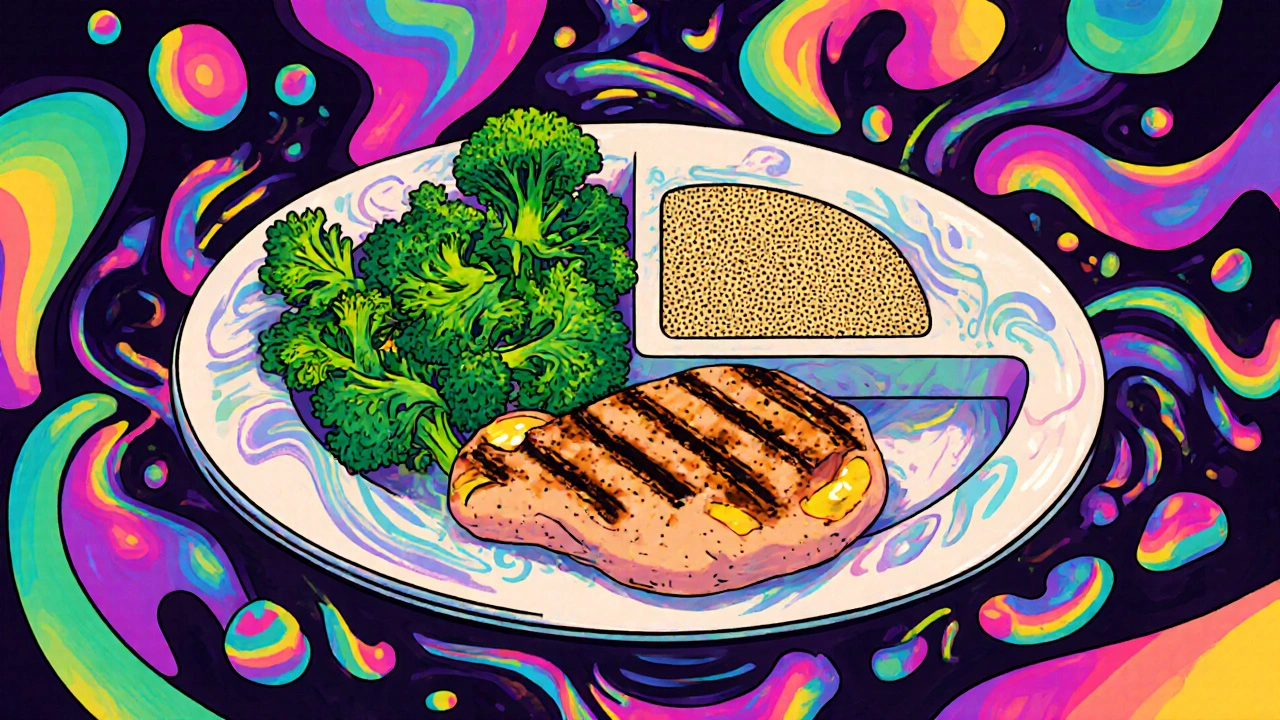Prediabetes Diet: How Fiber, Protein, and Glycemic Index Can Reverse Your Blood Sugar Trend

What Prediabetes Really Means (And Why It’s Not a Life Sentence)
More than 96 million adults in the U.S. have prediabetes. That’s about 1 in 3 people. And 8 out of 10 of them don’t even know it. Your blood sugar is higher than it should be-but not high enough yet to be called type 2 diabetes. That’s the gray zone. But here’s the truth: this isn’t just a warning sign. It’s your last chance to turn things around.
Studies show that with the right changes, you can cut your risk of developing full-blown diabetes by 58% over three years. Not 20%. Not 30%. 58%. And the biggest tool you have? Your plate.
Fiber Isn’t Just for Digestion-It’s Your Blood Sugar’s Best Friend
Think of fiber like a slow-motion filter for sugar. When you eat foods high in fiber, especially soluble fiber, it forms a gel in your gut that slows down how fast sugar enters your bloodstream. That means no spikes. No crashes. Just steady energy.
The goal? 25 to 38 grams of fiber a day. That’s not hard if you know where to look. Non-starchy vegetables like broccoli, spinach, kale, and bell peppers give you 3 to 5 grams per serving. One cup of cooked lentils? Nearly 16 grams. A medium apple with skin? About 4.5 grams.
Don’t just grab any whole grain. The American Diabetes Association says at least half your grains should be whole. Swap white bread for sourdough rye. Swap instant oatmeal for steel-cut oats. One person on a diabetes forum said switching to steel-cut oats dropped their morning blood sugar by 30 points. That’s not luck. That’s fiber doing its job.
And yes, fortified low-fat dairy can help. But don’t count on milk for fiber. Focus on beans, lentils, whole grains, nuts, seeds, and veggies. That’s where the real power is.
Protein Doesn’t Just Build Muscle-It Stabilizes Blood Sugar
Protein doesn’t raise blood sugar like carbs do. In fact, it helps keep it steady. When you eat protein with carbs, it slows down digestion. That’s why pairing fruit with nuts or yogurt works so well.
Try this: one small apple with two tablespoons of natural peanut butter. Or a cup of berries with a scoop of plain Greek yogurt. Both are simple, doable, and keep glucose under control. One Reddit user said this combo kept their post-meal sugar under 140 instead of spiking to 180. That’s the difference between staying in prediabetes and sliding into diabetes.
Where you get your protein matters too. The ADA and other experts recommend lean meats, fish, eggs, tofu, and legumes. Red meat? Limit it. A 2020 study found that eating just 100 grams of red meat a day-about the size of a deck of cards-increased diabetes risk by 20%.
Plant-based proteins like lentils and chickpeas are double wins. They give you protein AND fiber. One meal, two benefits. No supplements needed. Just food.

Glycemic Index: Not a Fad-A Practical Tool
The glycemic index (GI) measures how fast a food turns into sugar in your blood. High GI? Fast spike. Low GI? Slow, steady climb.
White bread: GI 75. White rice: 73. Potatoes: 85. These aren’t just carbs-they’re sugar bombs waiting to happen.
Swap them for: quinoa (GI 53), sweet potatoes (GI 44), barley (GI 28), and legumes (GI 25-40). These aren’t exotic foods. They’re staples in the Mediterranean diet, which is consistently recommended by the ADA, Cleveland Clinic, and the International Diabetes Federation.
A 2022 study showed that people who ate a low-GI diet (average GI 45) lowered their HbA1c by 0.5% in just six months. That might sound small, but a 0.5% drop is the difference between staying in prediabetes and crossing into diabetes.
Don’t obsess over every number. Just make smarter swaps. Choose brown rice over white. Choose whole grain pasta over regular. Eat your potatoes cold-they become resistant starch, which lowers their GI.
The Plate Method: Simple, Visual, and Works
You don’t need to count calories or track macros. You just need to relearn what a healthy plate looks like.
Use this rule: half your plate = non-starchy vegetables. One-quarter = lean protein. One-quarter = whole grains or starchy veggies (like sweet potato or legumes).
That’s it. No scales. No apps. Just your eyes.
A 2022 ADA survey found that people who used this method were 27% more likely to stick with their diet long-term. Why? Because it’s simple. It’s visual. And it works with real food.
Try it at dinner tonight. Load up on broccoli, zucchini, or salad. Add grilled chicken or baked fish. Then a small scoop of quinoa or brown rice. You’ll feel full. You won’t crash. And your blood sugar will thank you.
What to Avoid-And Why
Some foods aren’t just low in nutrition-they actively work against you.
- Added sugars: Less than 10% of your daily calories. That’s about 12 teaspoons max. A single soda? 8 teaspoons. One granola bar? Often 10. Read labels. If sugar is in the top three ingredients, skip it.
- Refined carbs: White bread, pastries, sugary cereals, crackers. They’re fiber-free and spike sugar fast.
- Unhealthy fats: Butter, lard, cream, coconut milk, hard margarines. These raise bad cholesterol and worsen insulin resistance. Swap for olive oil, avocado, nuts, and seeds.
- Artificial sweeteners: Don’t fall for the “sugar-free” trap. Some studies suggest they may still trigger cravings and disrupt gut bacteria. Stick to water, unsweetened tea, or sparkling water with lemon.

Real People, Real Results
One woman in the UK, 58, started the Mediterranean-style diet after her A1c hit 6.1%. She swapped white rice for barley, ate beans three times a week, snacked on almonds instead of biscuits, and walked 30 minutes after dinner. In six months, her A1c dropped to 5.4%. She’s no longer prediabetic.
A man in Australia joined a structured program. He lost 5.2% of his body weight. His triglycerides dropped. His HDL went up. His risk of diabetes fell by 58%.
These aren’t miracles. They’re results from consistent, simple changes.
It’s Not About Perfection-It’s About Progress
Here’s the hard truth: most people fail because they try to change everything at once. You don’t need to go vegan. You don’t need to give up all carbs. You just need to make better choices, most days.
Start with one thing. Add a veggie to lunch. Swap your morning cereal for oatmeal. Eat fruit with a handful of nuts. Drink water instead of soda.
Small steps. Daily. That’s how you reverse prediabetes.
What You Can Do Today
- Check your fridge. Remove one high-GI food (white bread, sugary cereal, soda).
- Buy one new low-GI food (quinoa, lentils, sweet potatoes).
- Plan one meal using the plate method: half veggies, quarter protein, quarter whole grain.
- Pair your next snack with protein: apple + peanut butter, berries + Greek yogurt.
- Walk for 10 minutes after dinner. Movement helps your body use sugar better.
You don’t need a miracle. You need a plan. And you already have everything you need to start.